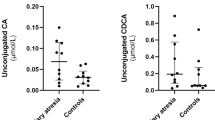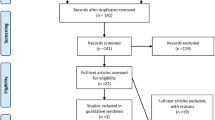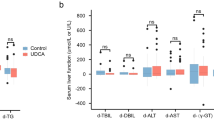Summary
Eighteen patients with total extrahepatic cholestasis undergoing PTCD were classified into three groups, depending on the bilirubin decrease rate at two weeks after PTCD. Serum and biliary esterified bile acids in each group were measured before PTCD and at 24 hours, 48 hours, 1 week, and 2 weeks after PTCD. Bile acids were measured by Okuyama’s methods (HPLC), and esterified bile acids were calculated from the difference between samples treated with sulfatase or β-glucuronidase for enzymatic hydrolysis and untreated samples measured at the same time. The following results were obtained.
The percentages of biliary esterified bile acids in total bile acids were as follows: before PTCD, in the fair improvement group, sulfate (S) = 6.4 ± 4.6 % (mean ± S.D.), glucuronide (G) = 11.7 ± 9.0 % ; in the poor improvement group, S = 2.8 ± 1.6 %, G = 1.0 ± 0.9 % and at 24 hours after PTCD, in the fair group, S = 9.1 ± 7.5 %, G = 7.5 ± 4.3 % ; in the poor group, S = 2.9 ± 2.4 %, G =1.7 ± 1.1 %. The percentages of esterified bile acids in the fair group were higher than in the poor group, and significant differences were noted in G (p<0.05). Thus PTCD is expected to reduce jaundice in cases with high percentages of biliary esterified bile acids before and shortly after PTCD.
Similar content being viewed by others
References
Makino I, Sjövall J, Norman A, et al: Excretion of 3ß-hydroxy-5-cholenoic acid 3α-hydroxy-5-cholanoic acids in urine of infants with biliary atresia. FEBS Lett 1971;15:161–164
Bremmelgaad A, Alme B: Analysis of plasma bile acid profiles in patients with diseases associated with cholestasis. Scand J Gastroentel 1980;15:593–600
Okuyama S, Kokubun N, Higashidate S, et al: A new analytical method of individual bile acids using high performance liquid chromatography and immobilized 3α-hydroxysteroid dehydrogenase in column form. Chem Lett 1979:1443–1446
Okuyama S: Analysis of free, glycine-and taurine-conjugated individual bile acids using high performance liquid chromatography and immobilized 3α-hydroxysteroid dehydrogenase in column form. Jpn J Clin Pathol 1981;29 (5):446–458
Takagi K, Okuyama S, Okumura K, et al: New analytical method for sulfated individual bile acids using high-performance liquid chromatography, immobilized 3α-and ß-hydroxysteroid dehydrogenase in column form and NAD+. Vitamins (Japan) 1986;60 (4):165–172
Okumura K, Okuyama S, Takagi K, et al:New analytical method for conjugated individual 3/3-hydroxy bile acids and its glucuronides using HPLC, immobilized 3 -(3 hydroxysteroid dehydrogenase in column form and NAD+. Vitamines (Japan) 1986;60 (4):157–164
Shimizu T, Yoshida K:The rule of the serum bilirubin changes after the biliary decompression in patients with severe jaundice. Acta Hepat Jap 1978;19:479–485 (in Jpn)
Palmer RH, Bolt MG:Bile acid sulfates I. Synthesis of lithocholic acid sulfates and their identification in human bile. J Lipid Res 1971;12:671–679
Back P, Spaczynski K, Gerok W:Bile-salt glucuronides in urine. Hoppe-Seyler’s Z Physiol Chem 1974;355:749–752
Takigawa H, Otsuka H, Beppu T, et al:Quantitative determination of bile acid glucuronides in serum by mass fragmentgraphy. J Biochem 1982;92:985–998
Ozawa K:Changes of bile contents and reduction of jaundice by percutaneous transhepatic cholangial drainage in obstruc-tive jaundice. Jpn J Gastroenterol Surg 1979;80:916–930
Shirakawa Y:Hepatic bile production and bile acid metabolism after relief of biliary obstruction. Jpn J Gastroenterol surg 1981;82:633–646
Takigawa H, Beppu T, Seyama Y: Profiles of bile acids and their glucuronide and sulfate conjugates in the serum, urine and bile from patients undergoing bile drainage. Gut 1984;26:38–42
Eklund A, Norlander A, Norman A:Bile acid synthesis and excretion following release of total extrahepatic cholestasis by percutaneous transhepatic drainage. Eur J Clin Invest 1980;10:349–355
Dooley JS, Bartholomew C, Summerfield JA, et al: The biliary excretion of sulfated and non-sulfated bile acids and bilirubin in patients with external bile drainage. Clin Sci 1984;67:61–68
Cleland DP, Bartholomew C, Billing BH:Hepatic transport of sulfated and non-sulfated bile acids in the rat following relief of bile duct obstruction. Hepatology 1984;4:477–483
Fröhling W, Stiehl A, Czygan P, et al:Induction of bile acid glucuronide formation in children with intrahepatic cholestasis. Bile acid metabolism in health and disease, Lancaster, MTP 1976;101:101–104
Author information
Authors and Affiliations
Rights and permissions
About this article
Cite this article
Suzuki, S., Nakazawa, S., Okuyama, S. et al. Change in serum and biliary esterified bile acids in patients with extrahepatic cholestasis during percutaneous transhepatic cholangiodrainage. Gastroenterol Jpn 23, 165–173 (1988). https://doi.org/10.1007/BF02799029
Received:
Accepted:
Issue Date:
DOI: https://doi.org/10.1007/BF02799029




